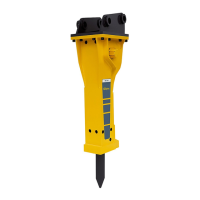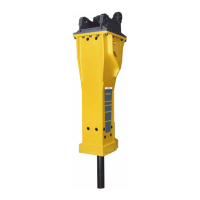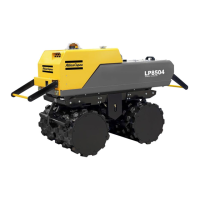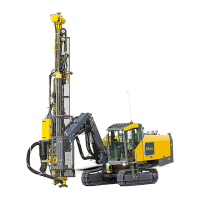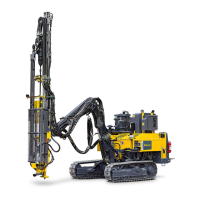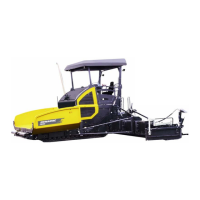Depressurising the hydraulic
system
Even when you have switched off the carrier, a
considerable residual pressure can still be present
in the hydraulic system.
A residual pressure can still be present in the
hydraulic breaker even after you have
disconnected the quick-release couplings or closed
the shut-off valves.
The hydraulic breaker can only be depressurised
using the hydraulic system of the carrier, by
allowing hydraulic oil to drain to the tank via the
return connection.
If the hydraulic breaker is fitted with a high-
pressure accumulator, it can take longer to relieve
the pressure in the hydraulic system to the tank,
since a larger volume of oil has to be drained
away.
Depending on the type of hydraulic breaker, the
internal leaks, the oil temperature, the type of
hydraulic oil and the design of the hydraulic
installation of the carrier, the time required to
relieve the pressure can vary.
Depending on the hydraulic system of the carrier
you will have to consider using various measures
in order to depressurise the hydraulic system.
Case 1:
If measurement connections are present in the
supply pipe to the hydraulic breaker, with which the
depressurised state can be checked using a
suitable gage. In order to depressurise the
hydraulic breaker you must observe the following
steps:
1. The hydraulic breaker must be connected to
the hydraulic system of the carrier device, i.e.
the hydraulic hoses must be connected up and
the respective shut-off valves in the supply pipe
and in the connection to the tank must be
opened.
2. Depressurise the hydraulic system according to
the manufacturer's safety and operating
instructions for the carrier.
3. Measure the pressure with a suitable gage at a
measurement connection in the supply pipe to
the hydraulic breaker.
4. If residual pressure is still present, wait until the
pressure has been completely relieved.
5. When you have made sure that no more
pressure is present in the hydraulic system,
you must disconnect the hydraulic connection
to the carrier. Close the shut-off valves or
disconnect the quick-release couplings, so that
no hydraulic oil can flow back from the carrier.
Case 2:
If no facility for measuring the pressure is present
in the supply pipe to the hydraulic breaker and the
return pipe is connected to the tank without an
intermediate valve connection, you must observe
the following steps in order to depressurise the
hydraulic breaker:
1. Ensure that the hydraulic oil in the hydraulic
breaker and in the carrier has a temperature of
at least 0 °C. If necessary, pre-heat it to at least
0 °C.
2. The hydraulic breaker must be connected to
the hydraulic system of the carrier, i.e. the
hydraulic hoses must be connected up and the
respective shut-off valves in the supply pipe
and in the connection to the tank must be
opened.
3. Depressurise the hydraulic system according to
the manufacturer's safety and operating
instructions for the carrier.
4. You must wait at least another 30 minutes until
the pressure has been relieved through
leakages.
Only after this period of time will there be no
more residual pressure present in the hydraulic
system of the hydraulic breaker.
5. When you have made sure that no more
pressure is present in the hydraulic system,
you must disconnect the hydraulic connection
to the carrier. Close the shut-off valves or
disconnect the quick-release couplings, so that
no hydraulic oil can flow back from the carrier.
Case 3:
If no facility for measuring the pressure is present
in the supply pipe to the hydraulic breaker and the
return pipe is connected to the tank via
intermediate valves, which for example close off or
pressurise the return pipe, you must observe the
following steps in order to depressurise the
hydraulic breaker:
1. The hydraulic breaker must be connected to
the hydraulic system of the carrier, i.e. the
hydraulic hoses must be connected up and the
respective shut-off valves in the supply pipe
and in the connection to the tank must be
opened.
2. Depressurise the hydraulic system according to
the safety and operating instructions from the
carrier manufacturer, and where appropriate,
those of the manufacturer of the hydraulic
installation for the attachment.
HB 2000, 2000 DP, 2500, 2500 DP Safety and operating instructions
© Construction Tools GmbH | 3390 5090 01 | 2016-05-23
Original instructions
43
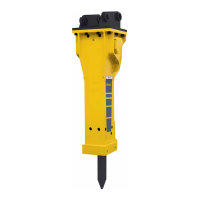
